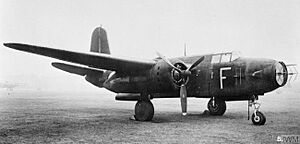Turbinlite facts for kids
The Turbinlite was a super powerful searchlight. It was put into the front of some British Douglas Havoc planes during the early part of World War II. These planes were called "night fighters." The idea was for the Havoc plane to find enemy bombers using its radar. Then, it would turn on the bright searchlight to light up the bomber. Other friendly fighter planes flying nearby could then see the bomber and shoot it down. However, the Turbinlite didn't work very well. By early 1943, newer, faster night fighters with their own radar came along. This meant the Turbinlite planes were no longer needed.
Contents
Why Was the Turbinlite Needed?
During World War II, finding enemy planes at night was very hard. Early radar systems were big and hard to use. They needed two-engine planes, like the Bristol Blenheim. But these planes weren't fast enough to catch German bombers like the Heinkel 111 or Dornier Do 17. Single-engine fighters were fast enough, but they couldn't find the bombers in the dark.
People wondered how to best find and shoot down enemy bombers at night. One idea was to have a plane carry a powerful searchlight along with radar. This plane would find the bomber and light it up. Then, faster single-engine fighters, which didn't have radar, could easily see the bomber and shoot it down. This seemed like a good plan because single-engine fighters were much faster than the German bombers.
How the Turbinlite Was Developed
Around this time, a new plane called the Douglas A-20 Havoc started to be used. It was faster than the Blenheim. So, people decided to try out the searchlight idea with the Havoc.
In September 1940, a man named Sidney Cotton thought of the idea of an "aerial target illumination" (ATI) searchlight for night fighters. He got help from William Helmore, an RAF officer. They worked together to create the Turbinlite.
The searchlight itself was built by GEC. It was placed in the nose (front) of the Havoc plane, behind a clear screen. The huge light needed a lot of power. This power came from heavy lead-acid batteries stored in the plane's bomb bay. These batteries could power the very bright 135,000-watt searchlight for about two minutes. The Havoc's own weapons were removed from its nose to make space for the light.
The Havoc also had a radar system called AI Mk.IV. It had special antennas sticking out from the sides, top, and bottom of the plane. These changes were made at a repair base. The plane was then called the Havoc I Turbinlite.
The plan was for the unarmed Havoc Turbinlite to find enemy bombers using its radar. Then, it would turn on the Turbinlite to light up the target. This would help accompanying Hurricane fighters to see the bomber and shoot it down.
Turbinlite in Action
About 31 Havoc I Turbinlites were made. Later, 39 more were built, called Havoc II Turbinlites.
The Turbinlite system only had one confirmed success. On the night of April 30, 1942, a He-111 bomber was spotted and shot down. This happened thanks to a Hurricane from 253 Squadron and a Havoc from 1459 Flight working together.
The idea behind the Turbinlite became old-fashioned when new, better radar systems came out. These new radars could be used on faster night fighters like the Bristol Beaufighter and the de Havilland Mosquito. These new planes could find and attack bombers on their own. Because of this, Turbinlite planes were taken out of service by early 1943.
Interestingly, later in the war, Germany used a similar idea called Wilde Sau (wild boar). Their fighters would attack British bombers at night without radar. But by then, the huge fires caused by British bombing raids lit up the sky. This made it much easier for fighters to see the bombers from far away. So, a special searchlight plane like the Turbinlite was no longer needed.
Units That Used Turbinlite Planes
Several RAF units used the Havoc I Turbinlite and Havoc II Turbinlite planes. In September 1942, many of these smaller "Flights" became part of new squadrons.
| Unit | Time in Use |
|---|---|
| No. 1451 (Fighter) Flight RAF No. 530 Squadron RAF |
May 22, 1941 to September 8, 1942 September 8, 1942 to January 25, 1943 |
| No. 1452 (Fighter) Flight RAF No. 531 Squadron RAF |
July 7, 1941 to September 8, 1942 |
| No. 1453 (Fighter) Flight RAF No. 532 Squadron RAF |
July 10, 1941 to September 8, 1942 |
| No. 1454 (Fighter) Flight RAF No. 533 Squadron RAF |
June 27, 1941 to September 8, 1942 |
| No. 1455 (Fighter) Flight RAF No. 534 Squadron RAF |
July 7, 1941 to September 2, 1942 |
| No. 1456 (Fighter) Flight RAF No. 535 Squadron RAF |
November 24, 1941 to September 2, 1942 |
| No. 1457 (Fighter) Flight RAF No. 536 Squadron RAF |
September 15, 1941 to September 8, 1942 |
| No. 1458 (Fighter) Flight RAF No. 537 Squadron RAF |
December 6, 1941 to September 8, 1942 |
| No. 1459 (Fighter) Flight RAF No. 538 Squadron RAF |
September 20, 1941 to September 2, 1942 |
| No. 1460 (Fighter) Flight RAF No. 539 Squadron RAF |
December 15, 1941 to September 2, 1942 |
These Turbinlite Havocs often worked with other fighter squadrons nearby. For example, 1453 Flight worked with No. 151 Squadron RAF and No. 486 Squadron RNZAF. The Havocs would light up targets for these fighters to attack.
Other Uses Considered
The Turbinlite was also thought about for another job: lighting up enemy U-boats (submarines) on the surface at night. However, another invention called the Leigh light proved to be better for this task.
See Also
- List of aircraft of the Royal Air Force



